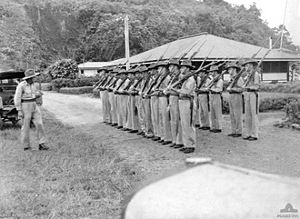- New Guinea Volunteer Rifles
-
New Guinea Volunteer Rifles 
The Salamaua platoon of the NGVR on parade in April 1940Active 1939–1943
1951–1973Country  Australia
AustraliaBranch Army Type Militia Role Infantry Size One battalion Motto Per angusta ad augusta (Through Trial to Triumph) Colors Cream over Red, under Green bar March Imperial Echoes Decorations United States Distinguished Unit Citation Battle honours Rabaul, Wau, South West Pacific 1942–43 Insignia Unit Colour Patch Regimental Flower Flame of the Forest The New Guinea Volunteer Rifles (NGVR) was an infantry battalion of the Australian Army. It was initially raised as unit of the Militia in New Guinea upon the outbreak of World War II in 1939 and saw active service against the Japanese during the conflict before being disbanded in 1943. Following the war the unit was re-raised in 1951 as part of the part-time Citizens Military Force, and it served in this role until it was disbanded in 1973 shortly before Papua New Guinea's independence.
Contents
History
World War II
The NGVR was formed as a Militia battalion in September 1939 from white settlers in New Guinea, and following the Japanese landings in early 1942 it was activated for full-time service. Between January and May, with a strength of just 500 men, the NGVR monitored the Japanese bases which had been established in the Huon Gulf region until the arrival of Kanga Force at Wau, being the only Allied force in the area. NGVR personnel also helped rescue 217 survivors of Lark Force from Rabaul in February and March 1942. The battalion then established observation posts and camps overlooking the main approaches and reported Japanese movements, all the time planning their own offensive. Later, in a series of raids NGVR inflicted significant casualties on the Japanese, and led them to believe that they faced a much larger opposing force.[1]
On 28 June 1942, the NGVR and the newly arrived 2/5th Independent Company carried out a highly successful attack on the Japanese garrison in Salamaua, killing at least 113. The Japanese were subsequently defeated in the Battle of Wau in January and February 1943, relieving the pressure on the NGVR. However, due to significant attrition the battalion was subsequently disbanded in late-1943, and its surviving members became part of the Australia New Guinea Administrative Unit (ANGAU). For their actions the unit was awarded a Distinguished Unit Citation by the United States.[1]
Post war
After the war the re-raising of NGVR was approved in July 1949, reforming as the Papua New Guinea Volunteer Rifles (PNGVR) on 17 March 1951 as a 'whites-only' reserve unit of the Citizens Military Forces (CMF) in the Australian Army.[2] The unit had evolved into a 'mixed race' battalion in the mid-1960s, and by 1969 only one-fifth of PNGVR members were Europeans.[3] Amid concerns about the ability of the fledgling nation of Papua New Guinea to finance a large military capability on its own, and with a questionable need to maintain a CMF type unit in the army of an independent PNG, the PNGVR was ultimately disbanded in 1973, shortly before independence, leaving the regular Pacific Islands Regiment as the only infantry unit in the new Papua New Guinea Defence Force.[4][5]
Battle honours
- World War II: Rabaul, Wau, South West Pacific 1942–43.[citation needed]
Commanding officers
- Post War
- Lieutenant Colonel N.R. McLeod (1950)
- Lieutenant Colonel E. F. Madden (1951–1953)
- Lieutenant Colonel T.W. Young (1953–1955)
- Lieutenant Colonel J.K. Lynch (1955–1957)
- Lieutenant Colonel W.H. Wansley (1957)
- Major D.H.C. Lloyd (1957)
- Lieutenant Colonel J.K. Murdoch (1958–1960)
- Lieutenant Colonel R.T. Eldridge (1960–1962)
- Lieutenant Colonel R.D. Newman (1962–1965)
- Lieutenant Colonel M.A. Bishop (1965–1968)
- Lieutenant Colonel K.E. Gallard (1968–1971)
- Lieutenant Colonel W.A. Harrington (1971–1973)[6]
Notes
- ^ a b Downs 1999, pp. 27–28.
- ^ Dennis et al 1995, p. 449.
- ^ Sinclair 1992, p. 274.
- ^ Sinclair 1992, p. 277.
- ^ "On this day – 17 March". Army History Unit (AHU). http://www.defence.gov.au/Army/ahu/On_This_Day/March/17_March.htm.
- ^ Sinclair 1992, p. 7.
References
- Dennis, Peter; Grey, Jeffrey; Morris, Ewan; and Robin Prior (1995). The Oxford Companion to Australian Military History (First ed.). Melbourne: Oxford University Press. ISBN 0195532279.
- Downs, Ian (1999). The New Guinea Volunteer Rifles NGVR 1939—1943 A History. Broadbeach Waters: Pacific Press. ISBN 187515003X.
- McCarthy, Dudley (1959). South–West Pacific Area – First Year: Kokoda to Wau. Australia in the War of 1939–1945. Series 1 – Army. Canberra: Australian War Memorial. http://www.awm.gov.au/histories/chapter.asp?volume=21.
- Sinclair, James (1990). To Find a Path: The Life and Times of the Royal Pacific Islands Regiment: Volume I - Yesterday's Heroes 1885–1950. Brisbane: Boolarong Publications. ISBN 0731691202.
- Sinclair, James (1992). To Find a Path: The Papua New Guinea Defence Force & The Australians to Independence: Volume II - Keeping the Peace 1950–1975. Brisbane: Boolarong Publications. ISBN 1863330623.
Further reading
- Huxley, Jim (2007). New Guinea Experience: Gold, War and Peace. Loftus: Australian Military History Publications. ISBN 0980320453, 9780980320459.
External links
Categories:- Australian World War II battalions
- Military units and formations established in 1939
- Military units and formations disestablished in 1973
- Infantry units and formations of Australia
Wikimedia Foundation. 2010.

